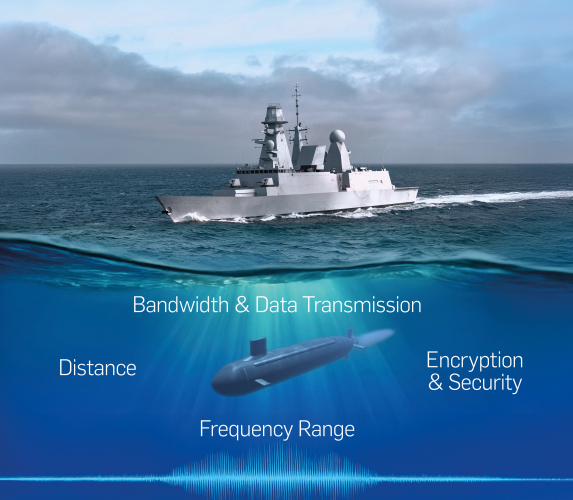Challenges of Underwater Communications

The underwater environment presents unique challenges to effective communications, primarily due to the physical properties of water and its impact on signal propagation, especially for industries such as defense, marine research, and offshore energy.
Distance: Signals underwater experience significant attenuation, meaning their strength decreases with distance. Unlike in air, radio waves are poorly transmitted underwater, limiting effective communication to short distances unless alternative methods are used.
Bandwidth and data transmission: The amount of data that can be transmitted underwater is severely limited. Acoustic waves, the most common medium for underwater communication, have lower frequencies compared to radio waves, resulting in a narrower bandwidth and slower data transfer rates.
Frequency range: Low-frequency waves can travel longer distances but at the cost of data speed, while high-frequency waves offer higher data rates but are effective only over shorter distances. Striking a balance between these two factors is a persistent challenge.
Encryption and security: The need for secure communication is critical in applications such as naval operations. Encryption is possible but adds complexity, especially given the limited bandwidth available.
Image created by IA.
Current Solutions
Acoustic communication: Acoustic modems are the most widely used technology for underwater communications. They transmit sound waves, which travel more effectively in water than electromagnetic waves. Systems such as Sercel's MATS 3G excel in providing reliable acoustic communication for industrial applications.
Optical communications: Under certain conditions, optical signals using light waves can provide high data rates. However, this method is limited by water clarity and is only effective over short distances.
Hybrid systems: Combining acoustic, optical, and even electromagnetic methods can leverage the strengths of each technology. For example, a hybrid system could use acoustics for long-range communication and optical signals for high-bandwidth, short-range data transfer.
Networking approaches: Underwater networks, such as underwater wireless sensor networks (UWSNs), use multiple communication nodes to extend range and improve reliability.
Future Research and Innovation
Improved modulation techniques: Research into advanced modulation schemes aims to increase data rates while minimizing errors in underwater environments.
AI and machine learning: Machine learning algorithms could optimize signal processing and dynamically adapt communication protocols to changing underwater conditions.
Vector sensors: Advanced vector sensors enhance signal detection and improve the efficiency of underwater communications.
Materials science: New materials that better transmit signals underwater could enable innovative communication devices.
Sercel's MATS 3G: A Reliable Industrial Solution
Among the current technologies, Sercel's MATS 3G acoustic modem stands out as a reliable solution for industrial underwater communications. Designed to meet the rigorous demands of offshore operations, it provides a robust platform for transmitting data over extended distances with high reliability.
MATS 3G is an excellent example of how existing technologies can address the constraints of underwater communications in practical applications. It provides a reliable industrial alternative today, bridging the gap between theoretical research and real-world applications.

